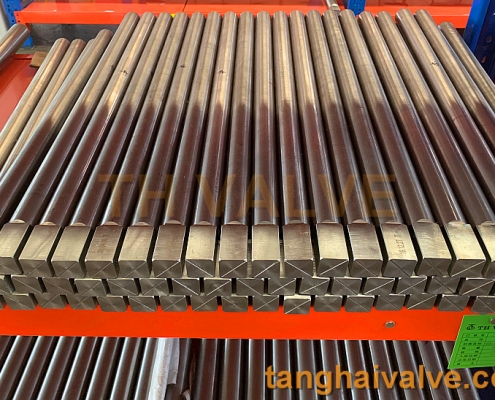Valve material and valve standards-(8)- Monel alloy application
4. Application of Monel alloy:
The A and E levels of M35-1, M35-2 and QQ-N2-88 are usually used to manufacture refined Monel alloy pumps,

buttefly valve stem shaft parts (6)
valves and accessories. The B-grade (3.5%Si) Monel alloy with the highest Si content is mainly used to manufacture shafts and wear-resistant rings that require good wear resistance due to its high strength, corrosion resistance and wear resistance. Class D (4.0% Si) Monel alloy is used to manufacture parts that require higher wear resistance and corrosion resistance.
Monel alloy valves have two types: integral and internal. The integral Monel alloy valve means that the valve shell and internal parts are all Monel, which is mainly used in the HF acid regeneration tower part of the alkylation unit of the refinery. Due to the high HF acid regeneration temperature (149°C) and high water content, an overall alloy valve is required. In addition, the overall Monel alloy valve is also used in the production of ashless additives for catalysts in refineries and high-concentration chlor-alkali systems in chlor-alkali plants. Situation.
The Monel alloy internal valve means that the valve housing is made of carbon steel or stainless steel, and the internal valve is made of Moenl alloy. The Monel alloy valve with carbon steel as the shell is mainly used in the low temperature area of the HF calculation system of the alkylation unit of the refinery. The use of carbon steel is good for low temperature (≤71°C) anhydrous hydrofluoric acid (HF) However, carbon steel will form a film on its surface due to corrosion when used in this working condition for a long time. If carbon steel is used in the valve sealing part, the film formed after corrosion will affect the sealing performance of the valve. It should be pointed out that the commonly used Cr13 type sealing material for carbon steel valves cannot resist the corrosion of HF acid, and the internal material is much cheaper for Monel alloy valves. The Monel alloy valve with carbon steel as the shell can also be used in working conditions such as sea water. The valve housing is made of stainless steel Monel alloy internal valve, which is used in ethylene, propylene, liquid oxygen, pure oxygen, sea water and other working conditions. The monolithic Monel alloy valve and Monel alloy internal valve used in the alkylation unit require a pressure level of CL300 from a safety point of view. The pressure level of Monel alloy internal valve for other working conditions is CL150 and CL300. Or PN116-614Mpa etc.
5. Melting and casting of monel alloy:
The smelting and casting technology of Monel alloy is the key to determine whether the qualified Monel alloy castings can be produced. Because Moenl alloy has developed dendrites, shrinkage cavities and porosity, the tendency of gas absorption (hydrogen absorption, oxygen absorption) is great, and it will Sulfurizing chemical reaction occurs with molding materials. From a safety point of view, Monel alloy valves are required to undergo radiographic inspection in accordance with Class A pipeline valves in highly toxic and dangerous media such as hydrofluoric acid, chlorine and hydrogen chloride gas. . Although the American standard points out that casting M35-1 can be welded, in fact its weldability is extremely poor, and the quality of repaired castings is difficult to guarantee. The density of M35-1 alloy is 8163t/m3 (at 20°C), the solidification shrinkage rate is 21mm/m, and the alloy melting point is 1315-1345°C. The Class A and Class E of M35-1, M35-2 and QQ-N2-88 are delivered as cast. Although there are many grades of cast Monel alloy, when used to cast Monel alloy valve castings, M35-1 in ASTMA494 is mainly used.
Cast Monel alloy and deformed Monel alloy have little change in chemical composition (Table 4), but this change satisfies its better deformability for deformation and gold, while it provides better casting for cast alloys. performance. This is the reason why cast Monel alloy grades are used when casting, and deformed Monel alloy grades are used when selecting rolling materials.
Table 4. Commonly used cast and deformed Monel alloy chemical composition of valves (%)
| Grade name | chemical composition /% | ||||||||
| C | Mn | Si | P | S | Cu | Fe | Ni | others | |
| M35-1 | ≤0.35 | ≤1.5 | ≤1.25 | ≤0.03 | ≤0.03 | 26-33 | ≤3.5 | Ba | |
| Monel400 | ≤0.30 | ≤2.0 | ≤0.5 | ≤0.024 | Ba | ≤2.5 | 63-70 | ||
| MonelK500 | ≤0.25 | ≤1.5 | ≤0.5 | ≤0.01 | Ba | ≤2.0 | 63-70 | Al2.5-3.5, Ti0.35-0.85 | |
6. Conclusion
The current U.S. technical standards for Monel alloys include ASTM, SAE, AMS (American Aeronautical Standards Institute), MIL (U.S. Department of Defense Standards), ANSI, ASME and QQ (American Federal Standards). For the Monel alloy of the same grade, different technical specification systems are adopted, not only the representation method of the grade is different, but the number and content of the specification are not completely the same. Usually military products use MIL, QQ or AMS specifications, and civil products use ASTM and ASME specifications.
TH Valve is a professional manufacturer of butterfly valve, gate valve, check valve, globe valve, knife gate valve, ball valve with API, JIS, DIN standard, used in Oil, Gas, Marine industry, Water supply and drainage, fire fighting, shipbuilding, water treatment and other systems, with Nominal Diameter of DN50 to DN1200, NBR/EPDM/VITON, Certificates & Approvals: DNV-GL, Lloyds, DNV, BV, API, ABS, CCS. Standards: EN 593, API609, API6D.
Related news /knowledge:
Valve material and valve standards-(7)- Monel alloy;
The difference between carbon steel and cast steel;
Valve body and material classification;
What is the material of the main parts of the butterfly valve?-(1);



 © Copyright 2020 Tianjin Tanghaidongyang Valve Co., Ltd. All Rights Reserved.
© Copyright 2020 Tianjin Tanghaidongyang Valve Co., Ltd. All Rights Reserved.